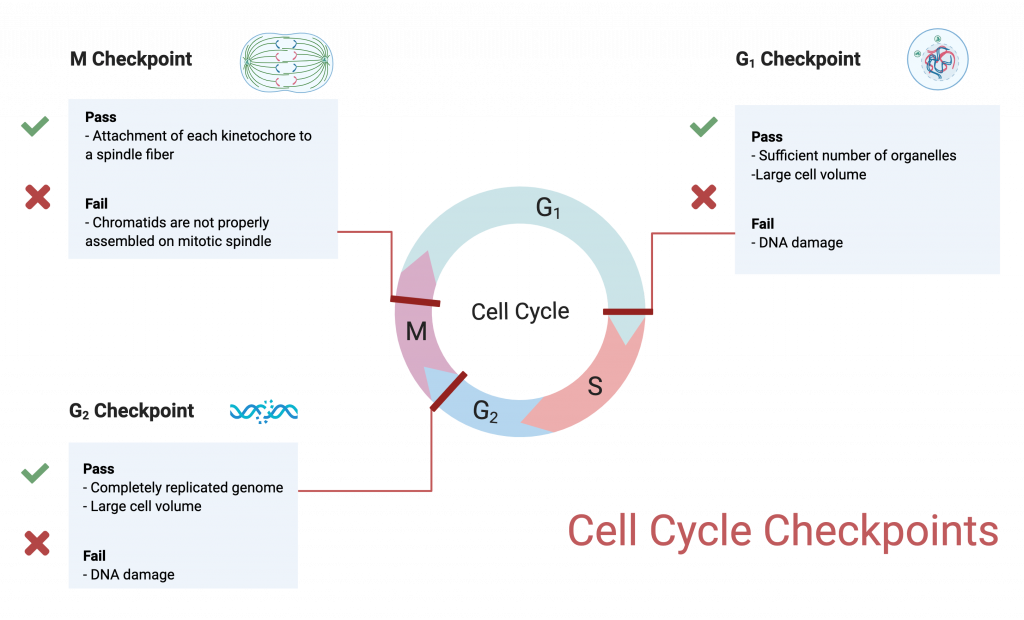17.1 Cell Cycle Checkpoints
Regulation at Internal Checkpoints
It is essential that the daughter cells produced be exact duplicates of the parent cell. Mistakes in the duplication or distribution of the chromosomes lead to mutations that may be passed forward to every new cell produced from an abnormal cell. To prevent a compromised cell from continuing to divide, there are internal control mechanisms that operate at three main cell-cycle checkpoints: A checkpoint is one of several points in the eukaryotic cell cycle at which the progression of a cell to the next stage in the cycle can be halted until conditions are favorable. These checkpoints occur near the end of G1, at the G2/M transition, and during metaphase.

The G1 Checkpoint
The G1 checkpoint determines whether all conditions are favorable for cell division to proceed. The G1 checkpoint, also called the restriction point (in yeast), is a point at which the cell irreversibly commits to the cell division process. External influences, such as growth factors, play a large role in carrying the cell past the G1 checkpoint. In addition to adequate reserves and cell size, there is a check for genomic DNA damage at the G1 checkpoint. A cell that does not meet all the requirements will not be allowed to progress into the S phase. The cell can halt the cycle and attempt to remedy the problematic condition, or the cell can advance into G0 and await further signals when conditions improve.
The G2 Checkpoint
The G2 checkpoint bars entry into the mitotic phase if certain conditions are not met. As at the G1 checkpoint, cell size and protein reserves are assessed. However, the most important role of the G2 checkpoint is to ensure that all of the chromosomes have been replicated and that the replicated DNA is not damaged. If the checkpoint mechanisms detect problems with the DNA, the cell cycle is halted, and the cell attempts to either complete DNA replication or repair the damaged DNA.
The M Checkpoint
The M checkpoint occurs near the end of the metaphase stage of karyokinesis. The M checkpoint is also known as the spindle checkpoint, because it assesses whether all the sister chromatids are correctly attached to the spindle microtubules. Because the separation of the sister chromatids during anaphase is an irreversible step, the cycle will not proceed until the kinetochores of each pair of sister chromatids are firmly anchored to at least two spindle fibers arising from opposite poles of the cell.
Apoptosis
What happens if a cell fails a checkpoint? It will be arrested at the checkpoint and the cell will attempt to repair the damage. However, if the damage cannot be repaired, the cell will undergo apoptosis. Apoptosis, or programmed cell death, allows a cell to die in a controlled manner that prevents the release of potentially damaging molecules from inside the cell. Apoptosis is highly regulated, and depends on a series of protein-protein interactions.
When a cell undergoes apoptosis, its mitochondria burst open, the cellular organelles are destroyed, mRNA is degraded, the nuclear envelope fragments, and the nuclear DNA is chopped up into short fragments. Finally, the cell is disassembled and fragments into small apoptotic bodies, which are removed by phagocytes (immune cells that engulf harmful foreign invaders and the remains of apoptotic cells).
Apoptosis is a common and necessary process — in your body, approximately 50-70 billion cells per day undergo apoptosis. Not all of these cells are potentially cancer cells; there are many reasons that apoptosis occurs. Apoptosis is also a necessary process during development.
mechanism that monitors the preparedness of a eukaryotic cell to advance through the various cell-cycle stages
programmed cell death

